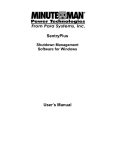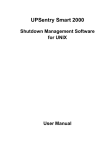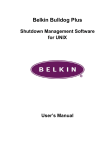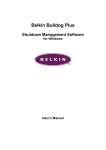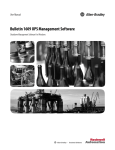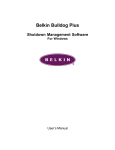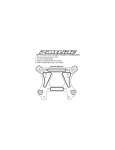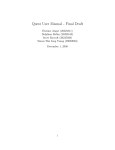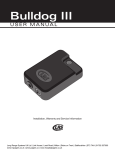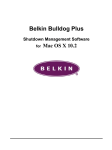Download Sentry Bulldog Shutdown Management Software (For UNIX
Transcript
Sentry Bulldog Shutdown Management Software (For UNIX Series) User Manual Table of Contents Introduction............................................................................................. 4 Sentry Bulldog Installation........................................................................ 5 Sentry Bulldog Services ........................................................................... 6 Sentry Bulldog Monitor ............................................................................ 7 Networking ............................................................................................. 8 Remote Monitor and Control..................................................................... 9 Sentry Bulldog Monitor Operation ........................................................... 11 Top Layers Buttons ............................................................................... 12 System Menu ....................................................................................... 13 Configuration Window ............................................................................ 16 Devices Menu ....................................................................................... 17 Notification Users: Pager List ................................................................. 18 Notification Users: E-Mail....................................................................... 19 Notification Users: Network Broadcast .................................................... 20 UPS Menu............................................................................................ 21 Schedule.............................................................................................. 23 Action .................................................................................................. 24 Action: Shutdown.................................................................................. 25 Action: Paging ...................................................................................... 26 Action: E-Mail....................................................................................... 27 Action: Receptacle Control..................................................................... 28 Voltage Sensitivity................................................................................. 29 Advanced UPS Property ........................................................................ 30 Network Menu....................................................................................... 31 Remote Wakeup ................................................................................... 32 SNMP.................................................................................................. 33 HTTP ................................................................................................... 37 Control Menu ........................................................................................ 38 View Menu ........................................................................................... 41 Event Log ............................................................................................. 42 History Graph ....................................................................................... 43 History Data ......................................................................................... 44 Remote Hosts....................................................................................... 45 2 Buttom Layer Buttons ............................................................................ 46 3 Introduction Congratulations on your purchase of Sentry Bulldog Shutdown Management Software to manage your Uninterruptible Power Supply (UPS). The goal of Sentry Bulldog is to monitor your UPS and take care of all your power management needs. Sentry Bulldog has the ability to properly shutdown your computer when an extended power outage occurs. Sentry Bulldog provides the most useful information about the UPS and all of your power management inquiries. We added the most popular network management protocol(SNMP) into Sentry Bulldog, Sentry Bulldog will translate UPS information into SNMP MIB to the appropriate Network Management Station(NMS) such as HP OpenView. To make use of resources on the Internet, Sentry Bulldog also supports HTTP protocol. That means you can monitor your UPS anywhere, anytime just using the Internet browser. Sentry Bulldog runs in the background as a daemon process on LINUX systems, and communicates to the UPS to keep your computer and equipment protected from any power problems. Furthermore, it gives you the most useful information about your UPS and computer. Sentry Bulldog features: 1.Graceful operating system shutdown 2.Schedule test, shutdown/restart UPS, turn on/off receptacles 3.Flexible events 4.Notification: Pager, e-mail and audible alarm, network broadcasting and SNMP 5.real-time values of voltage, current, frequency and loading... 6.History data & graph 7.Network monitor 8.Multi-computer shutdown/restart 9.Support Simple Network Management Protocol (SNMP) 10.Support HTTP, remote monitor and control using Internet browser 4 Sentry Bulldog Installation System Requirements: 1. Sentry Bulldog Monitor can run on X11R6 or above. Sentry Bulldog Setup: 1. To setup Sentry Bulldog, please login to your system as supervisor (root). 2. Place the Sentry Bulldog CD in your CD-ROM drive and change the working directory to /Unix/Linux. 2. Copy the only one file, Linux.tar, in your working directory to directory /tmp. 3. Change your working directory to /tmp. 4. Tar the file with the command: tar xvf Linux.tar. Note that some OS may require ““ before arguments. 5. Run ./install. 6. Follow the instructions from the install program. 7. After installation, Sentry Bulldog program files will be located in the directory /usr/local/bulldog. Notice: Some OS may not activate COM port as default. Thus, make sure the COM port connects to UPS has been activated before running Sentry Bulldog. The Sentry Bulldog software is comprised of two modules: l A UPS Monitoring Module (Sentry Bulldog Service, file name: upsd), that runs in the background as a daemon process on your system and communicates to the UPS. l A User Interface Module (Sentry Bulldog Monitor, file name: monitor), that enables you to control and configure Sentry Bulldog through the drop down menus and dialog boxes. It also a llows you to monitor the UPS through the Main Screen. 5 Sentry Bulldog Service Sentry Bulldog Service, which runs in the background, is a daemon process when the system starts up. You can also run Sentry Bulldog Service manually by typing the command /usr/local/bulldog/upsd. To stop Sentry Bulldog Service, type the command /usr/local/bulldog/upsd stop. 6 Sentry Bulldog Monitor Sentry Bulldog Monitor enables you to control and configure Sentry Bulldog through the drop down menu and dialog boxes. It also allows you to monitor the UPS through the Main Screen. Sentry Bulldog Monitor does not need to reside in the memory, the execution depends on the user's requirement. This can save precious system resources for you. After finishing the Sentry Bulldog installation, Sentry Bulldog Service automatic loads into memory and runs once the operating system starts up. To run the Sentry Bulldog Monitor, change your working directory to /usr/local/bulldog and type the command /usr/local/bulldog/monitor. Sentry Bulldog Monitor Main Screen: 7 Networking Sentry Bulldog software is comprised of two modules: Sentry Bulldog Service and Sentry Bulldog Monitor. You may run both the programs to monitor your localized UPS or run the programs on two different computers. 1. Multi-Computer Shutdown. Sentry Bulldog Service with 2 modes: Master and Slave. If there is a communication cable between the computer and a UPS, this computer called Master. The Master can monitor and control the connected UPS directly, as it also transmits the UPS information to the Slave(s). If a computer does not connect to the UPS directly but is powered by the same UPS, this computer called the Slave. Master communicates to Slave via a TCP/IP network. When a power event occurs, Master (Sentry Bulldog Service) gets the information and then transmits it to the Salve(s) (Sentry Bulldog Service). Each Sentry Bulldog Service executes different "Actions" (FlexEvent) such that the system manager can configure a different strategy to a different computer. For example: When power fails, file server and mail server won't shutdown until the UPS battery is low but some unimportant workstations execute shutdown OS after 5 minutes and the other workstations shutdown after 10 minutes. Shutdown workstations preserve more battery power for network servers. 8 Remote Monitor And Control 2. Remote Monitor and Control: Sentry Bulldog Monitor. Sentry Bulldog Monitor has the ability to monitor Local host and Remote host. You can run Sentry Bulldog Monitor without running Sentry Bulldog Service, Sentry Bulldog Monitor will search hosts in the LAN (Local Area Network) that runs Sentry Bulldog Service in the combo box. Click on the Host Selection combo box and it will provide a list of the searched hosts in the LAN. Select one, then Sentry Bulldog Monitor will connect to the selected host. The host is located on the internet, so you can also input the remote host IP address from the View – Remote Hosts menu to esta blish the connection. 9 Remote Monitor And Control (cont.) 3. Remote Monitor and Control: Internet Browser. Another way to remote monitor Sentry Bulldog Service is by using the Internet Browser. Launch the Microsoft Internet Explorer or Netscape Communicator, type the IP address in the URL a nd press enter you will get the UPS information. You can change the network port number to prevent conflict with other WEB server programs. If the port number is not 80 you have to type URL like this: http://172.16.176.141:2000 where 2000 is the port number you assigned. 10 Sentry Bulldog Monitor Operation The Main Screen has 7 areas that present information on the operating status of your UPS. These areas are discussed in the following sections. Host Selection: Press the combo box to select hosts that runs Sentry Bulldog Service in the LAN. Users can monitor or control (need password) remote UPS. Connection Indication: The sine wave will appear while the communication between Sentry Bulldog Monitor and Sentry Bulldog Service is established. Information Display: Press Bottom Layer Buttons to change the information that is displayed in this area. Recent Event Log: Shows the last 10 event logs in the combo box, click on the combo box to pull down and see the logs. 11 Top Layer Buttons Top Layer Buttons These buttons used to speed up your operation. Refer to the dialog boxes in the menu. Configuration: Same as the System-> Configuration in the menu. Meters: Same as the View-> Meters in the menu. Event Log: Same as the View-> Event Log in the menu. History Graph: Same as the View-> History Graph in the menu. SENTRY Bulldog Monitor Main Menu The Main Screen has a menu bar at the top with 4 main options: System: This menu allows you to set the Sentry Bulldog and computer p arameters. Control: This menu allows you to set UPS buzzer, outlet, and test ... View: The View menu allows you to see the real-time values and history event or history data. Help: The Help menu allows you to access the online help system. 12 System Menu The system menu allows you to configure the UPS and monitor screen parameters. When you select the System menu from Main Menu bar, a drop down menu appears offering you the following menu options: Login: Used for Remote Monitor. User must pass the pas sword verification before he/she can control or configure the UPS. Configuration: The Configuration menu allows you to tailor various Sentry Bulldog parameters. Monitor Screen: Allows you to change display items in the Scroll screen of Information Display Area Window: This menu allows you to change the display items in the Information Display Area. The items in the menu refer to each button in the Bottom Layer Buttons. Close Monitor: Stop Sentry Bulldog Monitor. Login When Sentry Bulldog Monitor becomes a Remote Monitor (connect to different host) you have to pass the password verification if you want to do configuration or control the UPS, otherwise, you can only view the UPS information. If the user runs Sentry Bulldog Service and Sentry Bulldog Monitor in the same computer, you can do your configuration or control the UPS without a password. To change your password, please choose the Set Password from the Configure Network menu 13 System Menu (cont.) Monitor Screen This dialog box allows you to change display item in the Scroll screen o f Information Display Area a. Meters: Press the Main button in the Bottom Layer Buttons, there are two meters in the information area. You can change the display items of the two meters. b. Scroll Window: Press the Scroll button in the Bottom Layer Buttons, the scroll window display in the information area. This item allows you to change the display step and items. Window This menu allows you to change the display items in the Information Display Area. The items in the menu refer to each button in the Bottom Layer Buttons. 14 System Menu (cont.) Close Monitor Close Sentry Bulldog Monitor and leave Sentry Bulldog Service running. 15 Configuration Window The Configuration Screen has a menu bar at the top with three main options: Devices: This menu allows you to configure modem, pager and e -mail. UPS: The UPS menu allows you to plan the UPS schedule or do the Action... Network: This menu allows you to choose Master/Slave or configure SNMP, HTTP functions. Configuration Window UPS Communication Port: COM1, ... COM4. Port names are different from systems. Next UPS Test Date/Time: The date of the next user-initiated UPS self test. Setting from System->Configuration->UPS->Schedule. Next UPS Shutdown Date/Time: This field display the date of the next shutdown the computer and UPS. Setting from System->Configuration->UPS->Schedule. Next UPS Restart Date/Time: The date of the next restart UPS. Setting from System>Configuration->UPS->Schedule. Local Host IP: IP address of a computer, that runs Sentry Bulldog Monitor. Sentry Bullodg Service Mode: Sentry Bulldog Service acts as a Master or Slave. Remote Host IP: The host, that runs Sentry Bulldog Service. If Sentry Bulldog Monitor and Sentry Bulldog Service run on the same computer this field will be empty. 16 Devices Menu Devices Modem: To let Sentry Bulldog notify you via pager, you must setup the modem device. Sentry Bulldog will control the modem device using AT Command as default. a. COM Port: The communication port COM1, ...COM4. b. Baud Rate: Define the data transmitting speed. c. Initialize String: The string, that is sent to the modem before paging is a ttempted. d. Dial Prefix: The string, that added to the beginning of each of the Pager Number before they are sent to the modem. 17 Notification Users: Pager List Notification Users -- Pager List: The program will dial the modem to notify all of the pager number that are listed on the pager list. You can input your pager number by yourself. For example if, 060123456 is your pager number, each ',' tells modem to delay 2 seconds, the delay time is for waiting the response signal from switching then transmit the display number 119. 119 will appear on your pager LCD.To trigger the pager notification you must enable the Pager Action in the Action dialog box. a. Add: Add a new pager number. b. Modify: Modify the selected pager number. c. Delete: Delete the selected pager number. 18 Notification Users: E-Mail Notification Users -- E-Mail: You can also e-mail information to users when power event occurred. The e-mail function associate with Microsoft Exchange(or Outlook) to send e -mail so you must run the Microsoft Outlook before Sentry Bulldog send e-mail. Be sure to configure a default Microsoft Exchange profile before using Sentry Bulldog. Make sure that your profile contains all mail systems that you will be addressing e mail to. To trigger the e-mail notification you must enable the e -mail Action in the Action dialog box. a. Add: Add a new user. b. Modify: Modify the selected user name. c. Delete: Delete the selected user. 19 Notification Users: Network Broadcast Notification Users -- Network Broadcast: You can also broadcasting information to users when power events occur. The broadcast function associate with Microsoft Messager sends messages so you must run under the Windows NT operating system. To trigger the broadcasting notification you must enable the Broadcast Action in the Action dialog box. a. Domain: Enable this item to broadcast all the users in the domain, otherwise Sentry Bulldog will send messages to the hosts that user assigned. b. Add: Add a new machine name. c. Modify: Modify the selected machine name. d. Delete: Delete the selected name. Close: Close the Configuration window. 20 UPS Menu UPS Property: This dialog box allows you to configure the UPS COM port, battery replacement date,... etc. Load Warning and Load Severity are used to prevent UPS overload (see the UPS hardware user's manual). Load Warning will notify the user to reduce the load of the UPS. Load Severity will shutdown the computer to prevent overload. a. COM Port: COM1, ...COM4. b. Load Warning: Load warning. c. Load Severity: User must reduce UPS loading. d. Last Battery Replacement Date: Record last battery replacement date. e. Next Battery Replacement Date: The date of next battery replacement, Sentry Bulldog will notify user to replace the battery. f. Host Name: Local host name. 21 UPS Menu (cont.) Attached Devices: Assign the attached device name. When you are controlling the outlet, Sentry Bulldog will let you know which devices you are controlling. a. Select an Outlet Group: Assign an outlet group. Please see the back panel carefully, for some outlets may share one control relay, these outlets are called the outlet group. If you turn off outlet group1(for example: outlet1 and outlet2) then the UPS will stop power output to outlet1 and outlet2. b. Device Name: Assign the attached device names, for example: Outlet Group1 is for printer, Outlet Group2 is for computer. These records can improve the efficiency of your management. Don't forget to press the Update button. c. Update: Update your change. Log Management: (Please consider about the free space in your hard disk) a. Maximun Event Log Entries: Sentry Bulldog saves less than the assigned e ntries of the event log. b. Data Log Interval: Time to save a record of UPS data. c. Maximun Data Log Storage: It allows you to save how many months of UPS data files. 22 Schedule Schedule: This function allows you to shutdown, restart, test and turn on/off outlet. You can schedule up to 6 events. Setting is based on day, week or month and up to a period of 2 years. Choose the applicable schedule to set whether it be for: a. One Time: This set schedule is applicable for a single day. b. Daily: This set schedule is a pplicable for every day c. Weekly: This set schedule is applicable for once a week period. d. Monthly: This set schedule is applicable for once a month period. 23 Action Action: The action menu provides you with a list of events to choose from. The event and/or any combination of these actions can be selected from the Choose Event list box. Actions that are already enabled will show a check mark. To delay the actions, set the desired time for delay in the Delay combo box. a. Enable Auto-Save: Sentry Bulldog Service running on MS Windows will save opened files and close applications automatically when you enable this function. b. Choose Event: When you select one item in the list the action buttons will display current setting. Press button to do further configuration. c. Set Default: Set all the actions to default values. d. Delay: The power event must stay the delay time to trigger actions. All the actions will be described here. Stop All Action: Clicking on this terminates all the a ctions immediate ly. 24 Action: Shutdown Action - Shutdown: Shutdown/Hibernate/Suspend the operating system or shutdown UPS. Both Hibernate/Suspend are available only on MS Windows. If you select shutdown item, Sentry Bulldog will execute or ignore the AutoSave function depending on your selection (in the Action dialog box). But if you select the suspend or hibernate item, the program will ignore the Auto-Save function. The functions of shutdown, hibernate or suspend are the same as if you select the Shutdown... from Windows Start menu. Action - Logging: Permits you to log event as well as modify default logging message. You can see this message in the Event Log dialog box. Action - Broadcasting: Permits you to broadcast an event based on a set p eriod of time. If you want to be notified once, set the time period to "0". However, if you want to be notified more than once, set the time period to a bigger number. Each number corresponds to the times of notification. 25 Action: Paging Action - Paging: Permits you to set the time period of paging intervals. If you want to be notified once, set the time period to "0". However, if you want to be notified more than once, set the time period to a bigger number. Each number corresponds to the times of notification. Action- Command: Permits you to execute command files and set a period of time to delay its activation. To enable or disable this action, mark the Enable Command check box. Action - Alarm: Permits you to send out audible alarm instead o f a broadcast message. There is only buzzer alarm for Sentry Bulldog on LINUX. If you want to be notified once, set the time period to "0". However, if you want to be notified more than once, set the time period to a bigger number. Each number corresponds to the times of notification. 26 Action: E-Mail Action - e-mail: Permits you to send mail. If you want to be notified once, set the time period to "0". However if you want to be notified more than once, set the time period to a bigger number. Each number corresponds to the times of notification. You can edit the user list by clicking the Edit list button, and add, modify or delete any user name in the list. To enable or disable this action, mark the Enable e-mail check box. Action - SNMP Trap: Lets you send a SNMP trap when the relative power event occurs. To enable or disable this action, mark the Enable SNMP Trap check box. You also need to specify the SNMP Trap target hosts and community string, please see the SNMP dialog box in the Network menu. 27 Action: Receptacle Control Action - Receptacle Control: Permits you to control Receptacle Relay on or off. Each Receptacle Relay may control not only one outlet, please see the rear panel of your UPS or the UPS hardware user's manual. 28 Voltage Sensitivity Voltage Sensitivity: Adjust the UPS voltage sensitivity. Transfer Voltage: Change the low transfer voltage and high transfer voltage. This function lets your UPS suit the local power environment. a. Low Transfer Voltage: When utility power voltage is lower than the assigned value, the UPS will switch to backup. The output power is supplied from battery. b. High Transfer Voltage: When utility power voltage is higher than the assigned value, the UPS will switch to backup. The output power is supplied from battery. 29 Advanced UPS Property If your UPS doesn't support this function, the item will display a grayed area and the user cannot select this item. Enable Wakeup Computer: If your computer’s architecture is compatible to ATX and the BIOS supports RS-232 (RI) Wakeup function. You should enable this item to make the Schedule work correctly. Enable Resume Computer: Be sure the BIOS supports RS-232 (RI) Wakeup function. When Sentry Bulldog suspends the computer and the UPS detects the change of power status, UPS will resume the computer and let Sentry Bulldog notify the users. Enable Power Fail, Auto-Reboot: The timeline describes below, If you enable this function, the UPS will reboot to restart the computer. Otherwise, it will return back to normal state. Enable Economic Mode: Switch to UPS economic mode. UPS Periodic Auto-Test: Daily, weekly, biweekly and monthly. UPS starts the test procedure automatically when it reaches the test time. 30 Network Menu Network : Set Password: Set the Sentry Bulldog Service password. Choose Master/Slave: Set Sentry Bulldog Service mode. If the computer is connected to the UPS directly (with RS-232 cable or USB cable) then the Sentry Bulldog Service acts as a Master, otherwise it is a Slave. When Sentry Bulldog Service is a Slave you must assign the Master IP address such that the Slave can connect to the Master host and get the UPS information. a. Master: Configure the Sentry Bulldog Service to be a Master. The Master will forward the UPS information to a connected Slave(s). b. Slave: Configure the Sentry Bulldog Service be a Slave. c. Master IP Address: When Sentry Bulldog Service becomes a Slave you must assign the Master IP address such that the Slave can connect to the Master host and get the UPS information. If you leave the item empty or type a wrong address, Sentry Bulldog will show a disconnect message. 31 Remote Wakeup Remote Wakeup: To wake up the remote host, Sentry Bulldog sends a Magic Packet through the network. You must give the IP address and the network hardware address (MAC address) of the remote host. In Windows98, you can execute the "ipconfig /All" command under MS-DOS prompt to get the network card physical address of the local host. Or, input the "arp -a" command to see the remote host’s physical address. Your network card must support the remote wakeup feature and this function should be enabled. a. Sentry Bulldog Resume the Computer From Suspend Mode: Sentry Bulldog may force the computer into suspend mode (input power failed or other power events), program will wake up the remote hosts that enable this item when the local host is woken. b. Each Time Sentry Bulldog Startup: Program will wake up the remote hosts that enable this item when Sentry Bulldog starts up and connects to the UPS. 32 SNMP Select the Accept SNMP packet from any hosts, Sentry Bulldog will accept all the request commands and set commands. When you select the Accept SNMP packet from the following hosts, Sentry Bulldog receives only the hosts that you assigned. Once the power event occurs and the user enables the SNMP Trap in the Action dialog box, Sentry Bulldog will send the SNMP trap to the hosts that are listed in the Trap Target list box. To add, modify or delete the host, click on its respective command button. If the Sentry Bulldog Service you are connecting is running on LINUX series, and Windows 95/98 operating system, you can configure the SNMP parameters directly from the Sentry Bulldog: Select the Accept SNMP packet from any hosts, Sentry Bulldog will accept all the request commands and set commands. When you select the Accept SNMP packet from the following hosts, Sentry Bulldog receives only the hosts that you assigned. Once the power event occurred and user enables the SNMP Trap in the Action dialog box, Sentry Bulldog will send the SNMP trap to the hosts that listed in the Trap Target list box. To add, modify or delete the host, click on its respective command button If the Sentry Bulldog Service you are connecting is running on Windows NT or Windows 2000 operating system, you must install the SNMP Service and configure the SNMP parameters from your operating system: Sentry Bulldog will ignore the values that were set in the SNMP dialog box. To change the parameters of SNMP function, you should install the SNMP Service in the Network option. Select the SNMP Service from the Network option in the Control Panel and click the Property button to do your changes. 33 SNMP (cont.) If the Sentry Bulldog Service you are connecting is running on Novell NetWare operating system, all setting in this SNMP configuring dialog will not take any effect. Please edit the file SYS:\etc\Traptarg.cfg directly. 34 SNMP (cont.) SNMP Trap Number: Variable dupsCommunicationLost dupsCommunicationEstablished dupsPowerFail dupsPowerRestored dupsLowBattery dupsReturnFromLowBattery dupsLoadWarning dupsNoLongerLoadWarning dupsLoadSeverity dupsNoLongerLoadSeverity dupsLoadOnBypass dupsNoLongerLoadOnBypass dupsUPSFault dupsBatteryGroundFault dupsNoLongerBatteryFault dupsTestInPr ogress dupsBatteryTestFail dupsFuseFailure dupsFuseRecovered dupsOutputOverload dupsNoLongerOverload dupsOutputOverCurrent dupsNoLongerOutputOverCurrent dupsInverterAbnormal Trap No. Description 1 SEVER: Communication with the UPS failed 2 INFORMATION: Communication with the UPS reestablished 3 WARNING: Power failed! The UPS is operating on battery power 4 INFORMATION: Power restored! The utility power restored 5 SEVER: The UPS batteries are low and will soon be exhausted 6 INFORMATION: The UPS has returned from a low battery condition 7 INFORMATION: Loading percent of the UPS over the Load Warning value 8 INFORMATION: Returnd from Load Warning condition 9 Warning: Loading percent of the UPS over the Load Severity value 10 INFORMATION: Returned from Load Severity condition 11 WARNING: The UPS loads on bypass 12 INFORMATION: The UPS is not on bypass mod 13 SEVER: A general fault caused in the UPS 14 SEVER: The UPS battery ground fault 15 INFORMATION: The UPS recovered from battery ground fault 16 INFORMATION: The UPS test in progress 17 SEVER: The UPS test in progress 18 SEVER: The UPS fuse failed 19 INFORMATION: The UPS fuse recovered 20 SEVER: The UPS overload 21 INFORMATION: Recovered from UPS overload 22 SEVER: The UPS output over current 23 INFORMATION: Recovered from UPS over current 24 SEVER: The UPS inverter abnormal 35 SNMP (cont.) Variable dupsInverterRecovered Trap No. Description 25 SEVER: Recovered from UPS inverter abnormal dupsRectifierAbnormal 26 SEVER: The UPS rectifier abnormal dupsRectifierRecovered 27 INFORMATION: The UPS recovered from rectifier abnormal dupsReserveAbnormal 28 SEVER: The UPS rectifier abnormal dupsReserveRecovered 29 INFORMATION: The UPS rectifier abnormal dupsLoadOnReserve 30 INFORMATION: The UPS load on reserve dupsNoLongerLoadOnReserve 31 INFORMATION: The UPS no longer load on reserve dupsEnvOverTemperature 32 WARNING: The environment over temperature DupsNoLongerEnvOverTemperature 33 INFORMATION: The environment recovered from over temperatur DupsEnvOverHumidity 34 WARNING: The environment over humidit DupsNoLongerEnvOverHumidity 35 INFORMATION: The environment recovered from over humidity 36 HTTP Sentry Bulldog supports WEB Server for remote manager to get UPS information. User can use IE or the Communicator to connect to Sentry Bulldog Service. Even if your computer doesn't install Sentry Bulldog, you can monitor and control your UPS via the network. a. HTTP Root: The HTTP root path. All the html and gif files will be located here. b. Port Number: Default port number is 80 but if there is already one WEB server running you can change Sentry Bulldog Service HTTP port number to a different number. At the Internet Browser you can input http://172.16.176.141:2000 in the URL where 2000 is th e assigned port number. 37 Control Menu Control Shutdown Now: This command will execute the shutdown procedure at once. a. Restart: This function lets you restart the OS and UPS automatically after being shutdown. To start the OS and UPS for the next schedule, mark the Restart check box. b. Shutdown OS and UPS: Use this function to shutdown both OS and UPS. c. SHUTDOWN OS Only: Use this function to shutdown OS only. d. SUSPEND OS Only: Use this function to suspend your operating system. e. HIBERNATE OS Only: Use this function to hibernate your operating system. Cancel Shutdown: This menu enables you to terminate the current shutdown procedure. 38 Control (cont.) Turn Receptacle Relay On: Turn the selected receptacle relay on. Each Receptacle Relay may not control only one outlet, please see the rear panel of your UPS or the UPS hardware user's manual. a. Select a Receptacle Relay: Select a receptacle relay. b. Delay: Set the delay time to turn on the receptacle relay. c. Turn On: Execute the turn on command. Turn Receptacle Relay Off: Turn the receptacle relay off. Each Receptacle Relay may control not only one outlet, please see the rear panel of your UPS or the UPS hardware user's manual. a. Select a Receptacle Relay: Select a receptacle relay. b. Delay: Set the delay time to turn off the outlet group. c. Turn Off: Execute the turn off command. UPS Audible Alarm On: Enable the UPS buzzer from the Bottom Layer Buttons. Press the Status button to get the UPS buzzer status. UPS Audible Alarm Off: Mute UPS buzzer alarm. 10 Seconds Test: UPS switches to backup mode and output power is supplied by battery in 10 seconds. 39 Control (cont.) Deep Battery Test: UPS switches to backup mode and output power is supplied by battery until battery low. Cancel Test: This menu allows you to stop testing the UPS immediately. 40 View Menu Meters: The Sentry Bulldog supports up to 12 meters to be display in real-time values. Each meter has the ability to display all of the UPS values. Selecting different items from the Selection dialog box will display the selected item value. a. 2、4、6、8、12:Displayed meter number. b. Selection: Assign each meter to different UPS item value. c. Close: Close the meter window. 41 Event Log Event Log: This menu offers you the possibility of viewing past events. a. Exit: Close event log dialog box. 42 History Graph History Graph: Clicking on the History Graph opens a dialog box that contains information about UPS data in graph form. This information is available only if there is an accumulation of data. You can select the month and year you want to view. a. Horizontal Scale: Select the time scale. b. Vertical Scale: Select the value scale. c. Select Month: The UPS data in the month you want to see. d. Draw Item1(Blue): Draw the UPS item value by blue line. e. Draw Item2(Red): Draw the UPS item value by red line. f. Update: Update the graph. g. Exit: Close the history graph dialog box. 43 History Data History Data: Clicking on the History Data opens a dialog box that contains inform ation about UPS data in list form. This information is available only if there is an accumulation of data. You can select the month and year you want to view. a. Select Month: The UPS data in the month, that you want to see. b. Update: Update the list. c. Exit: Close the history data dialog box. 44 Remote Hosts Remote Hosts: Detect the hosts which running the Sentry Bulldog Service in the LAN. You can also type in the IP address and connect to the WAN. a. Search Result: The hosts will be listed in the Search Result list box. Select the host you want to connect and press the Connect button to establish the connection. b. Connect to this IP address: Sentry Bulldog will connect to the IP address, that you type in. c. Connect: Establish the network connection. Content: This online help. About: Sentry Bulldog version and copyright. 45 Bottom Layer Buttons Bottom Layer Buttons Each button shows the respective information in the Information Area. Main: General Information about the UPS. Tree: There are 2 subtrees in the Sentry Bulldog tree: System and UPS. System tree for host information and the status of Master/Slave connection, the UPS tree for all of the UPS information. Time: Display the time of the schedule, battery replacement date and countdown time. Status: UPS status. Diagram: Indicate the UPS current flow. Scroll: UPS data graph. Outlet: Display outlet status. (If your UPS cannot control outlet then this button disappears) Network: Indicate the connection of Master/Slave, Sentry Bulldog Monitor and Sentry Bulldog Service. Main UPS Health: 3 levels: Green, yellow and red. UPS Type: On line, off line, line interactive or 3 phase on line. UPS Model: The UPS model, which is being monitored by Sentry Bulldog. Firmware Version: Indicating the version status of the UPS internal code. Host Name: The host, which runs Sentry Bulldog. Rating VA: The UPS rating VA. Rating Input Voltage: The UPS rating input voltage. Rating Current: The UPS rating current. Rating Battery Voltage: The UPS rating battery voltage. Rating Input Frequency: The UPS rating input frequency. Test Result: Results of the last self-test. AC Source: Normal, battery or bypass. Battery Status: The status of battery. Battery Level: Percentage of battery level. Loading: Output loading percentage. Sentry Bulldog with the ability to change the display item of the meters, the referred menu item: System-> Main Screen. 46 Bottom Layer Buttons (cont.) Time Last Battery Replacement Date: To change the date of last battery replacement in the System-> Configuration UPS->UPS Property. Next Battery Replacement Date: To change the date of next battery replacement in the System-> Configuration UPS->UPS Property. Next 10 seconds Test Time: System-> Configuration UPS-> Schedule. Next Deep Test Time: System-> Configuration UPS-> Schedule. Next Shutdown UPS Time: system->Configuration UPS-> Schedule. Next Restart UPS Time: System-> Configuration UPS-> Schedule. Status Show all of the UPS status, red light indicates this event happened. Diagram Input and output power flow of UPS. Scroll Record the recent UPS data information. you can change the display item from System->Main Screen. Network Display all the Sentry Bulldog Service searched in the LAN. Outlet Display the UPS outlet status (If your UPS cannot control outlet this button disappeared). Status: Identify the current outlet status: Normal or shut. Next Turn Off Time: System->Configuration->UPS->Schedule Next Turn On Time: System->Configuration->UPS->Schedule 47















































